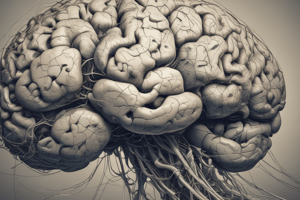Podcast
Questions and Answers
Where are olfactory receptors primarily located?
Where are olfactory receptors primarily located?
- In the nasal cavity (correct)
- In the throat
- In the mouth
- In the ears
What must happen for chemicals to be detected by olfactory receptors?
What must happen for chemicals to be detected by olfactory receptors?
- They must be exposed to light
- They must be vaporized
- They must be dissolved in mucus (correct)
- They must be heated to a particular temperature
Which structure in the tongue contains the taste receptors?
Which structure in the tongue contains the taste receptors?
- Papillae
- Lingual folds
- Salivary glands
- Taste buds (correct)
Which type of papillae on the tongue have taste buds?
Which type of papillae on the tongue have taste buds?
What are the three primary areas of the ear?
What are the three primary areas of the ear?
Which sensation is primarily detected by bitter receptors?
Which sensation is primarily detected by bitter receptors?
Which structure is responsible for transmitting sound vibrations from the eardrum to the inner ear?
Which structure is responsible for transmitting sound vibrations from the eardrum to the inner ear?
How are gustatory cells stimulated?
How are gustatory cells stimulated?
What is the primary function of the maculae in the vestibule?
What is the primary function of the maculae in the vestibule?
What part of the brain is responsible for the interpretation of smells?
What part of the brain is responsible for the interpretation of smells?
What is the function of the cochlear nerve in the hearing process?
What is the function of the cochlear nerve in the hearing process?
What role does the tectorial membrane play in hearing?
What role does the tectorial membrane play in hearing?
What triggers the bending of hair cells in the maculae?
What triggers the bending of hair cells in the maculae?
When are all special senses functional?
When are all special senses functional?
How does the auditory tube help with hearing?
How does the auditory tube help with hearing?
Which structure is responsible for detecting dynamic equilibrium?
Which structure is responsible for detecting dynamic equilibrium?
Which type of cell is primarily involved in the process of taste?
Which type of cell is primarily involved in the process of taste?
Which structure is NOT involved in the hearing process?
Which structure is NOT involved in the hearing process?
What is the primary function of the Organ of Corti?
What is the primary function of the Organ of Corti?
What type of movement does the cupula respond to?
What type of movement does the cupula respond to?
How do the senses of taste and smell interact?
How do the senses of taste and smell interact?
What process can lead to adaptation in hearing?
What process can lead to adaptation in hearing?
What is the role of otoliths in the vestibular system?
What is the role of otoliths in the vestibular system?
What distinguishes smell from taste in terms of receptor response?
What distinguishes smell from taste in terms of receptor response?
Flashcards are hidden until you start studying
Study Notes
Visual Pathway
- Optic tracts carry visual information to the thalamus.
- Axons from the thalamus form the optic radiation.
- Information from the right eye is processed in the left visual cortex, and vice versa.
- Visual cortex is located in the occipital lobe.
Anatomy of the Ear
- The ear consists of three areas: outer ear, middle ear, and inner ear.
The External Ear
- Primarily involved in hearing.
- Structures include:
- Pinna (auricle)
- External auditory canal
The Middle Ear (Tympanic Cavity)
- Air-filled cavity within the temporal bone.
- Contains three bones:
- Malleus (hammer)
- Incus (anvil)
- Stapes (stirrup)
- Vibrations from the eardrum move the malleus and transfer sound to the inner ear.
- Tympanic membrane covers the auditory canal opening.
- Auditory tube connects the middle ear to the throat, equalizing pressure when yawning or swallowing.
Inner Ear (Bony Labyrinth)
- A complex of bony chambers in the temporal bone.
- Key structures include:
- Cochlea (for hearing)
- Vestibule (balance)
- Semicircular canals (balance)
Organs of Hearing
- Organ of Corti located within the cochlea contains hair cells as receptors.
- Hair cells bend due to vibrations from the tectorial membrane, generating action potentials in the cochlear nerve.
- Nerve impulses are transmitted to the auditory cortex in the temporal lobe.
- Prolonged stimulation may lead to adaptation.
Organs of Equilibrium
- Receptors in the vestibule, called maculae, report head position and send information via the vestibular nerve.
- Anatomy of maculae consists of hair cells embedded in a gel-like otolithic membrane with otoliths that respond to head movement.
- Crista ampullaris in semicircular canals facilitates dynamic equilibrium through the stimulation of hair cells.
Chemical Senses - Taste and Smell
- Both senses utilize chemoreceptors activated by chemicals in solution.
- Taste involves four types of receptors, while smell can differentiate a broad spectrum of chemicals.
- Olfactory receptors reside in the roof of the nasal cavity, with long cilia that require chemical dissolution in mucus for detection.
- Impulses for smell travel via the olfactory nerve to the cortex for interpretation.
The Sense of Taste
- Taste buds, mainly found on the tongue, soft palate, and cheeks, contain gustatory cells with gustatory hairs that respond to chemicals in saliva.
- The tongue features various papillae:
- Filiform (sharp, no taste buds)
- Fungiform (rounded, with taste buds)
- Circumvallate (large, with taste buds)
- Taste sensations include:
- Sweet (sugars, saccharine)
- Sour (acids)
- Bitter (alkaloids)
- Salty (metal ions)
Developmental Aspects of the Special Senses
- Special senses begin development early in embryonic stages.
- Eyes form as outgrowths of the brain.
- All special senses are functional at birth.
Studying That Suits You
Use AI to generate personalized quizzes and flashcards to suit your learning preferences.




